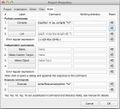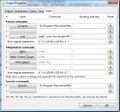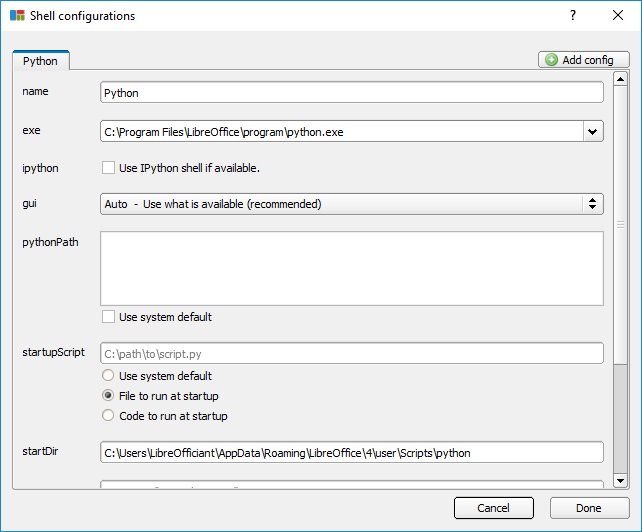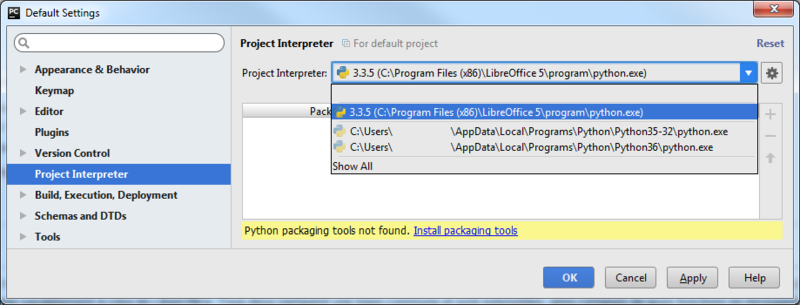Macros/Python Basics
TDF LibreOffice Document Liberation Project Community Blogs Weblate Nextcloud Redmine Ask LibreOffice Donate
Předmluva
Tato stránka představuje kroky umožňující vývoj maker LibreOffice Python v Integrated Development Environment (IDE). Konfigurace nebo nastavení předvoleb jsou uvedeny pro omezenou sadu free and open source (FOSS) IDE. Přímé úpravy a ladění pythonských maker v LibreOffice vyžaduje pouze rozšíření Alternative Python Script Organizer (APSO). V takovém případě lze obsah kapitoly Start, Connect, & Stop přeskočit.
( ... Dokumenty, Konfigurace, Inspekce objektu ... )
Užitečné balíčky LibreOffice
- LibreOffice 7.x
- LibreOffice Portable 6.x, winPenPack LibreOffice 6.x
- AppImage, Flatpak nebo Snap Linuxové obrazy jsou dostupné
Pro ty, kteří chtějí prozkoumat vzájemnou kompatibilitu:
- Apache OpenOffice 4.x, Apache OpenOffice Portable 4.x, winPenPack Apache OpenOffice 4.x
- OpenOffice.org Portable 3.2 (in french)
Nastavení projektu v IDE
Každé IDE vyžaduje jinou konfiguraci nebo nastavení.
Geany
Libreoffice nebo OpenOffice embedded Python vyžaduje explicitní definici v Geany dialozích Projects - Properties - Build:
-
MacOS - Vlastnosti projektu karta Sestavení.
-
GNU/Linux - Vlastnosti projektu karta Sestavení.
-
Windows - Vlastnosti projektu karta Sestavení.
Příklady hodnot:
- MacOS
- P1. Compile =
/Applications/LibreOffice.app/Contents/Resources/python -m py_compile "%f" - E1. Execute =
/Applications/LibreOffice.app/Contents/Resources/python "%f"
- P1. Compile =
- Linux
- P1. Compile =
opt/openoffice4/program/python -m py_compile "%f" - E1. Execute =
opt/openoffice4/program/python "%f"
- P1. Compile =
- Windows
- Python commands
- 1. Compile =
"D:\Program Files\LibreOffice 5\program\python" -m py_compile "%f" - 2. Interpret =
"D:\Program Files\LibreOffice 5\program\python"
- 1. Compile =
- Execute commands
- 1. Execute =
"D:\Program Files\LibreOffice 5\program\python" "%f" - 2. Unit Tests =
"D:\Program Files\LibreOffice 5\program\python" -m unittest discover
- 1. Execute =
- Python commands
Pyzo
Pyzo configuration dialog for embedded Python interpreters as of Shell - Edit shell configurations... menu:
PyCharm
What's in a Macro
A LibreOffice Python macro may look like:
import uno
def my_1st_macro():
# <span lang="en" dir="ltr" class="mw-content-ltr">Won't run directly in Anaconda, Geany, KDevelop, PyCharm or else</span>
doc = XSCRIPTCONTEXT.getDocument()
doc.getText().setString("Hello World!")
g_exportedScripts = my_1st_macro,Executing the above requires bridging together the IDE and LibreOffice. Once done UNO objects become accessible.
Up to five steps can be necessary to achieve this:
- Start LibreOffice as a service
- Connect to a service
- create a
XSCRIPTCONTEXTAdaptor
- Run the macro
- Stop LibreOffice as a service
While examples available on the internet do not resort to all these steps, their study exhibits coding guidelines that IDE_utils module borrows from in order to innocuously integrate in IDEs.
Start, Connect, Adapt, Run & Stop
The table below lists a few public (Libre/Open)Office Python macro examples. Their usage of the Start, Connect, Adapt, Run, Stop steps is indicated.
| Description | Start | Connect | Adapt | Run Debug |
Stop |
|---|---|---|---|---|---|
| a. LibreOffice and OpenOffice officehelper.py module | x | x | |||
| b. Office.bridge.py A bridge for IDE with XSCRIPTCONTEXT revisité, Feb. 2017 (in french) | x | x | x | ||
| c. Interface-oriented programming in OpenOffice / LibreOffice: automate your office tasks with Python macros, Sep. 2013 | x | x | |||
| d. unopy.py LibreOffice macro execution with PyCharm, Jan. 2014 (in japanese) | x | x | x | ||
| e. ooutils.py - Starting, Stopping and Connecting to OpenOffice with Python, Dec. 2008 | x | x | x | x | |
| f. Python UNO-bridge, Oct. 2008 | x |
IDE enablement
Based on these resources, requirements for Python macro enablement in IDEs can be summarised as:
- start, connect, adapt, run and stop steps to be optional
- Support multiple platforms i.e. essentially Linux, MacOS and Windows
- on-demand startup --options
- Permit pipe and/or socket connections
- decoupled coding using injection
- Provide Service pooling, context pooling
- and KISS
IDE_utils module proposal: A Runner() context manager class is responsible for starting and stopping soffice instances. An optional Runners.json configuration file contains service-options pairs holding the services to start and their running conditions. A connect() function bridges the actual IDE and LibreOffice instances. A ScriptContext() object is injected as XSCRIPTCONTEXT built-in. start() and stop() coding facilities are wrapping-up Runner() features. The module skeleton looks like:
#! # IDE_utils.py
import officehelper
RUNNERS = 'Runners.json'
class Runner(soffice=None): pass
class ScriptContext(): pass
_ctx = officehelper.bootstrap()
XSCRIPTCONTEXT = ScriptContext(_ctx)
def connect(host='localhost', port=2002, pipe=None): pass
def start(soffice=None): pass
def _stop(): passIDE_utils.py can be obtained from GitLab.
Recommended Use
import uno
def my_1st_macro(): pass # <span lang="en" dir="ltr" class="mw-content-ltr">Your code goes here</span>
g_exportedScripts = my_1st_macro, # <span lang="en" dir="ltr" class="mw-content-ltr">Published macros</span>
if __name__ == '__main__':
from IDE_utils import Runner, XSCRIPTCONTEXT
with Runner() as jesse_owens: # <span lang="en" dir="ltr" class="mw-content-ltr">Start/Stop, Connect/Adapt</span>
my_1st_macro # RunThe example above should be your preferred use for IDE_utils. As starting and stopping a service may not fit all situations, these steps are optional. That same module allows the customization of LibreOffice - or OpenOffice - services running conditions. "Getting Started" user guide provides detailed description of the 3 different ways to use IDE_utils:
- Resorting to (Libre/Open)Office default Python
officehelper.bootstrap()mechanism, - Letting
Runner()andScriptContext()objects take responsibility for start, connect, adapt, run and stop steps, - Deciding when to perform start, connect, adapt, run and stop steps.
Managing Documents (draft)
Opening a Document
Creating a Document
Saving a Document
Closing a Document
A General Purpose Converter
Bug Detection & Reporting
Examining (draft)
Examining LibreOffice
Configuration Properties
Path Settings
Getting & Setting DocumentProperties
Reporting OS File Properties
Setting Document Properties
Inspecting a Document for API Information
MRI, xRay & ObjectInspector
Listening (draft)
... catching document(s) events, catching URP bridge events...




